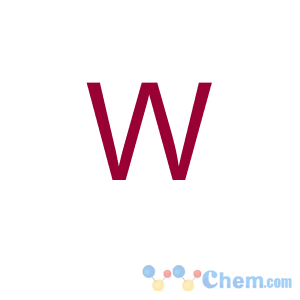Title: Tungsten
CAS Registry Number: 7440-33-7
Synonyms: Wolfram
Literature References: W; at. wt 183.84; at. no. 74; valences 6, 5, 4, 3, 2. Group VIB(6). Naturally occurring isotopes: 180 (0.135%); 182 (26.4%); 183 (14.4%); 184 (30.6%); 186 (28.4%); artificial radioactive isotopes: 173-179; 181; 185; 187-189. Discovered by C. W. Scheele in 1781, isolated in 1783 by J. J. and F. de Elhuyar. One of the rarer metals, comprises about 1.5 ppm of the earth's crust. Chief ores are
wolframite [(Fe,Mn)WO4] and scheelite (CaWO4). Found chiefly in China, Malaya, Mexico, Alaska, South America and Portugal. Scheelite ores mined in the U.S. carry from 0.4-1.0% WO3. Description of isoln processes: K. C. Li, C. Y. Wang,
Tungsten, A.C.S. Monograph Series no.
94 (Reinhold, New York, 3rd ed., 1955) pp 113-269; G. D. Rieck,
Tungsten and Its Compounds (Pergamon Press, New York, 1967) 154 pp.
Reviews: Parish,
Adv. Inorg. Chem. Radiochem. 9, 315-354 (1966); Rollinson, "Chromium, Molybdenum and Tungsten" in
Comprehensive Inorganic Chemistry vol. 3, J. C. Bailar, Jr.
et al., Eds. (Pergamon Press, Oxford, 1973) pp 623-624, 742-769. Review of toxicology and human exposure:
Toxicological Profile for Tungsten (PB2006-100007, 2005) 203 pp.
Properties: Steel-gray to tin-white metal; body centered cubic structure. d420 18.7-19.3; depends on extent of working. Hardness 6.5-7.5. mp 3410°. bp760 5900°. Spec heat (20°): 0.032 cal/g/°C. Heat of fusion 44 cal/g. Heat of vaporization 1150 cal/g. Electrical resistivity (20°): 5.5 mohm-cm. Stable in dry air at ordinary temps, forms the trioxide at red heat. Not attacked by water, but oxidized to the dioxide by steam. Very stable to acids, attacked only superficially by concd nitric acid or aqua regia. Powdered tungsten can be pyrophoric under the right conditions. Slowly sol in fused potassium hydroxide or sodium carbonate in presence of air; sol in a fused mixture of NaOH and nitrate. Attacked by fluorine at room temp; by chlorine at 250-300° giving the hexachloride in absence of air, and the trioxide and oxychloride in the presence of air.
Melting point: mp 3410°
Boiling point: bp760 5900°
Density: d420 18.7-19.3
CAUTION: Potential symptoms of overexposure to tungsten are irritation of eyes, skin, respiratory system; diffuse pulmonary fibrosis; loss of appetite, nausea, cough; blood changes. Potential symptoms of overexposure to tungsten carbide (cemented) are irritation of eyes, skin, respiratory system; possible skin sensitization to cobalt, nickel; diffuse pulmonary fibrosis; loss of appetite, nausea, cough; blood changes.
See NIOSH Pocket Guide to Chemical Hazards (DHHS/NIOSH 97-140, 1997) p 324.
Use: To increase hardness, toughness, elasticity, and tensile strength of steel; manuf alloys; manuf filaments for incandescent lamps and in electron tubes; in contact points for automotive, telegraph, radio and television apparatus; in phonograph needles.
Tungsten carbides (W2C, WC) used in rock drills, metal-cutting tools, wire-drawing dies. WC used as catalyst instead of platinum: Bennett
et al., Science 184, 563 (1974).

